The Best Cutting Boards, According to Our Very Detailed Testings
Dotdash Meredith and Yahoo Inc. may earn commission or revenue on some items through the links below.
We’re here to help you choose between plastic and wood boards, plus navigate size and price.
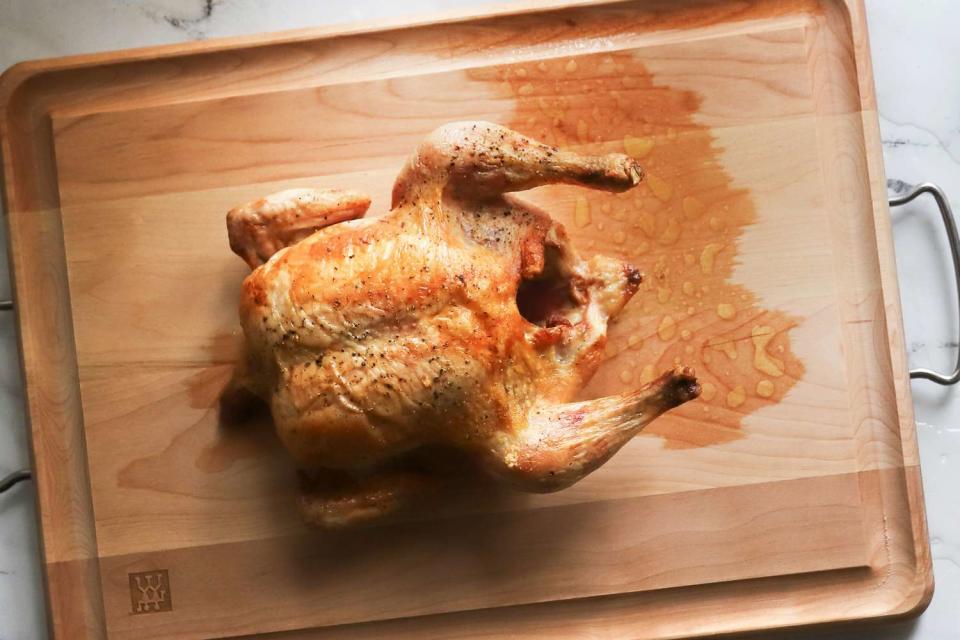
Serious Eats / Taylor Murray
Straight to the Point
Our favorite wooden cutting board is from The Boardsmith, while our budget-friendly pick is by IronWood Gourmet. For plastic cutting boards, we recommend the OXO cutting boards or the Yoshihiro as our high-end pick. For carving boards, we like The Boardsmith with an added juice groove.
Cutting boards are tricky to shop for. There's such a wide variance in price, material, and size! Because while a cheap miniature plastic cutting board may be sufficient for slicing limes, it’s not ideal for prepping a large amount of food, or using it with regularity. The best cutting boards are large, with big work surfaces so you have plenty of room to chop and get organized.
Although there are benefits to buying a plastic cutting board, we generally recommend wooden cutting boards due to their durability, longevity, and ease on knives (hard plastic can quickly dull a blade). That said, plastic is less expensive and easier to maintain.
To help you decide what’s right for you, we’ll break down the factors that’ll go into your decision process. We’ll also include which cutting boards to buy, based on our wooden, plastic, and carving board reviews.
The Winners, at a Glance
The Best High-End Wooden Cutting Board: The BoardSmith Maple End Grain Cutting Board
The Best Budget-Friendly Wooden Cutting Board: Ironwood Acacia End Grain Cutting Board
The Best Budget-Friendly Plastic Cutting Board: OXO 2-Piece Cutting Board Set
The Best High-End Plastic Cutting Board: Hayate Yoshihiro Cutting Board
The Best Carving Board: The BoardSmith Maple End Grain Cutting Board (with an added juice well)
Things to Consider
Wooden vs. Plastic Cutting Boards
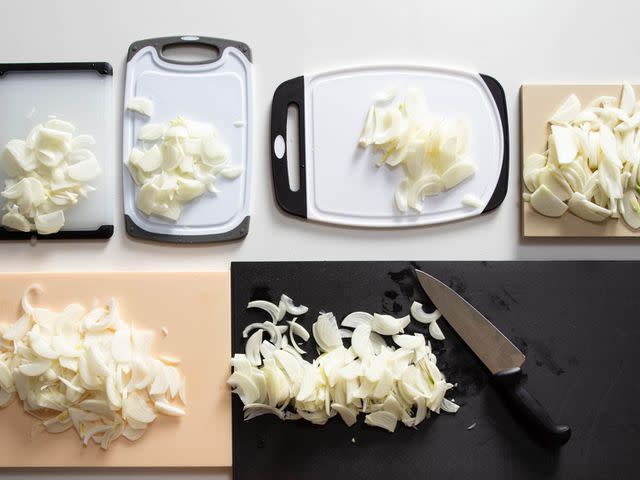
Serious Eats / Vicky Wasik
Neither wood nor plastic cutting boards are unequivocally “better.” Wooden board enthusiasts will praise their aesthetics, relative gentleness on knives, and natural material. Fans of plastic boards can claim easier maintenance and care, as well as a (usually) lower price point. But we think there’s value in having both on hand. Let’s take a look at where wood and plastic boards differ, excel, and struggle.
Which is more sanitary?: Conventional wisdom tells us that plastic is a more sanitary option than wood when it comes to cutting boards. This is a partial truth: while plastic is undeniably easier to sanitize, it can be an equal or even more inviting environment for harmful bacteria to linger. When plastic boards collect cuts and gashes due to repeated knife use, those grooves are an ideal place for bacteria to grow. Conversely, as we discussed in our review of wooden boards, the material’s porous nature isn’t necessarily a bad thing: the fiber network in the wood can trap bacteria and hold it under the surface until it dies.
Cleaning: Plastic is inarguably easier to clean and care for than wood. You can leave a plastic board in a sink full of dishes, soak it, and use cleaning agents on it. Even if bacteria festers, you can bleach a plastic board or pop it in the dishwasher. Wooden boards must be hand-washed, dried immediately, and treated with mineral oil to avoid warping and cracking.
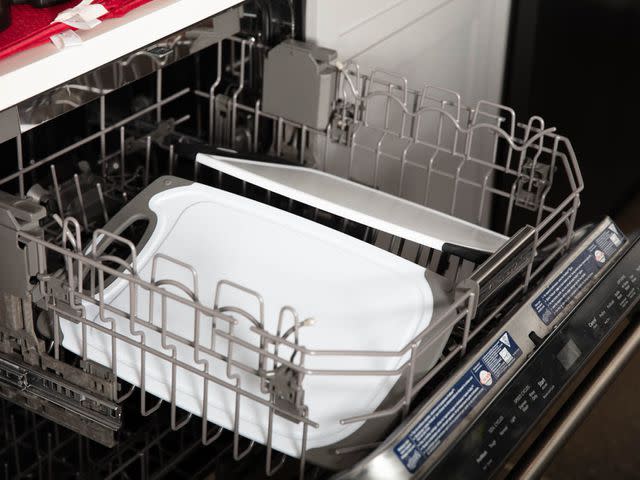
Serious Eats / Vicky Wasik
Knife Use: Every time you use a knife, you dull the blade. But the surface you’re cutting on will either expedite or slow that process. Different types of wood have different levels of porousness. Maple and walnut are good options, because they’re not too dense (a quality which is hard on knives), but not so soft that they immediately scratch. They are pricier than acacia, teak, and bamboo, but those materials can be unpredictably hard, and may result in a knife blade that dulls more quickly (we especially don’t recommend bamboo). Plastic also has varying levels of hardness, and can similarly affect a knife’s blade. In our review of plastic cutting boards, we noted that the grip of a plastic cutting board matters, as well. A too-slippery surface can be annoying—and dangerous—to use.
Longevity: Over time, the gashes and scratches in plastic boards will render them unusable. At that point, they must be thrown away. Wooden boards, on the other hand, will last indefinitely. Although they too will show signs of wear, they can be sanded down to reveal a fresh, new surface. (You shouldn’t have to do this more than once a year, even with heavy use. Be sure to apply a layer of oil after sanding and wiping clean).
Size
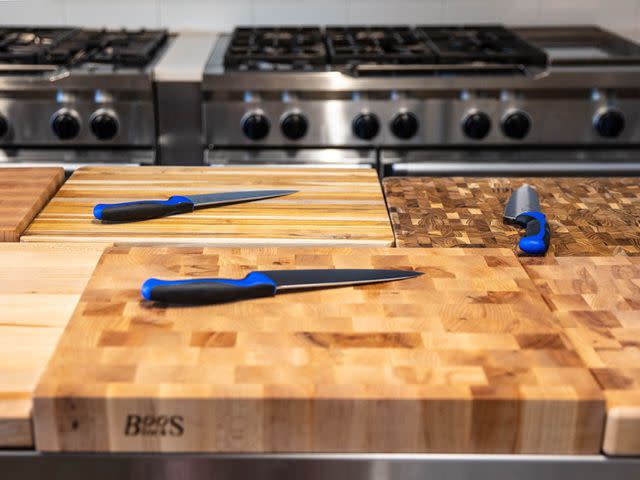
Serious Eats / Vicky Wasik
A cutting board is more than just a place to chop. We consider them to be extensions of our work surface, and favor large boards that approximate a workbench or extra-large chopping block. Look for boards that measure at minimum 12 by 18 inches to boost their efficiency. We also prefer boards with thick profiles: at least an inch and a half. This is less about making a visual statement—although the argument can be made that big, chunky boards double as decor when left on the counter. Rather, the thicker boards are more resistant to warping over time.
Read More: The 4 Best Wooden Cutting Boards, According to Our Tests
Price
Wooden cutting boards are typically more expensive than plastic cutting boards, although they are longer-lasting and don’t need to be replaced…unless they are thrown in the dishwasher, or become warped or cracked. But the cost varies widely among wooden boards. It’s worth noting that many of us have used wooden boards from The Boardsmith at home for years and they’ve never shown signs of warping or cracking, but they also cost more than $300 (our favorite plastic boards, from OXO, are $24 for two).
The Best Wooden Cutting Board: High-End: The BoardSmith Maple End-Grain Cutting Board

What we liked: High-quality end-grain cutting boards cost more than well-made edge-grain cutting boards. We’ve got recommendations for both varieties. Our tests revealed the Maple End Grain Cutting Board from The Boardsmith to truly top. This board is meticulously made, with no visual or structural imperfections. It’s also a generous two inches thick and we can tell you, first-hand, that it lasts for years and years with regular use (and of course, proper maintenance). For most folks, we'd recommend going with the 16- by 22-inch size.
(We also liked Brooklyn Butcher Blocks’ End Grain Maple Cutting Board. For a slightly more affordable option, we recommend the Maple Long-Grain Cutting Board, also from Brooklyn Butcher Blocks.)
What we didn't like: Besides the price being prohibitive, there's nothing we didn't like about this board. It's worth the investment.
Price at time of publish: $325.
Key Specs
Weight: 18 to 19 pounds (for the 16- x 22-inch board)
Customizations available: Feet; juice groove; finger grooves; sizing
Wood type: Maple
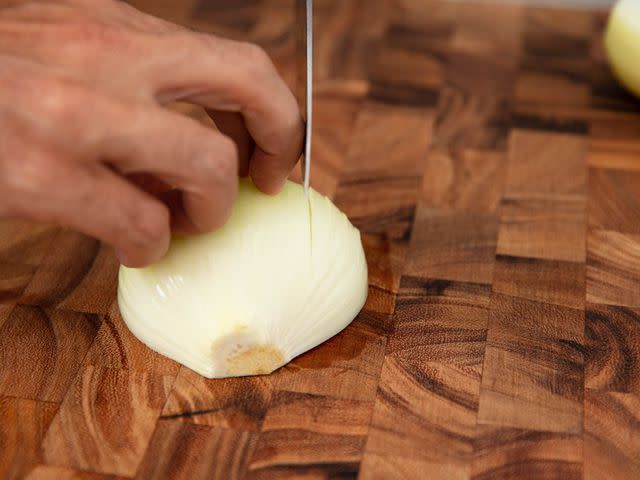
Serious Eats / Vicky Wasik
The Best Wooden Cutting Board: Budget-Friendy: Ironwood Gourmet End-Grain Acacia Wood Cutting Board

What we liked: This end-grain board from Ironwood Gourmet is more affordable, because it’s made from cheaper acacia wood. Although acacia is harder than maple, our high-end pick, it is very durable and resistant to warping and cracking. This board is also well under $100, making an extremely solid budget-friendly recommendation.
What we didn't like: It comes with non-slip feet, which makes one side of the board unusable.
Price at time of publish: $66.
Key Specs
Weight: 7.2 pounds
Customizations available: None
Wood type: Acacia
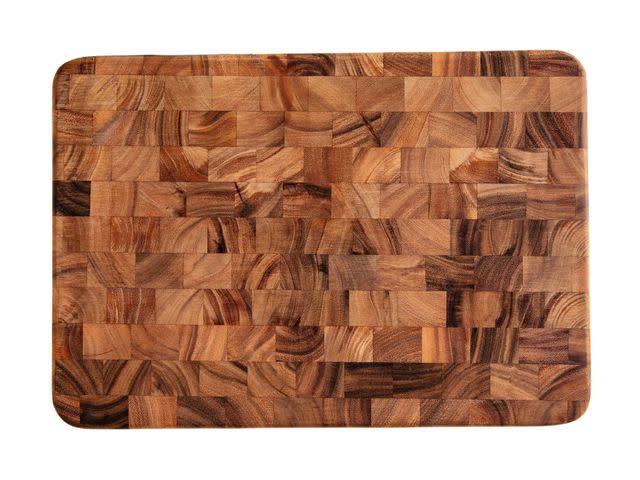
Serious Eats / Vicky Wasik
The Best Plastic Cutting Board: Budget-Friendly: OXO 2-Piece Cutting Board Set

What we liked: If you want a plastic board that can be knocked around, used heavily, and is available in a variety of sizes, you simply cannot beat OXO’s 2-Piece Cutting Board Set. The boards are thin enough to tuck into just about any drawer or cupboard when not in use, but they’re far from flimsy. We particularly liked the rubber bumpers on two edges of the board, which keep it from slipping around during use. Unlike grippy feet, the bumpers allow for the board to be flipped over and used on both sides.
What we didn't like: Nothing—really! These boards are staples in our test kitchen and in homes.
Price at time of publish: $24.
Key Specs
Weight: 2.03 pounds
Materials: Plastic with rubber trim
Care instructions: Dishwasher-safe
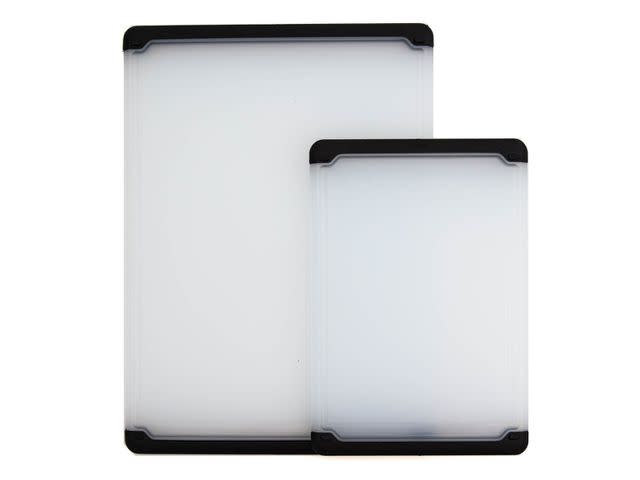
Serious Eats / Vicky Wasik
The Best Plastic Cutting Board: High-End: Hayate Yoshihiro Cutting Board

What we liked: The Hayate Yoshihiro Cutting Board will set you back $115, but it’s worth the unusually-steep-for-plastic price tag. It’s soft, and responds to knife blades similarly to wood boards and really for the kind of cook that likes to invest in their gear and take care of it. As we said in our review, "Designed to work with razor-sharp Japanese knives and the more gentle pulling motion chefs tend to use in Japan, the Hi-Soft board is only for folks who think they have the knives and knife skills to treat it with care." We like that it's available in a ton of (read: six) sizes, too.
What we didn't like: For some, this board may just be too expensive.
Price at time of publish: $115.
Key Specs
Weight: 4.75 pounds
Materials: Polyvinyl acetate
Care instructions: Hand-wash
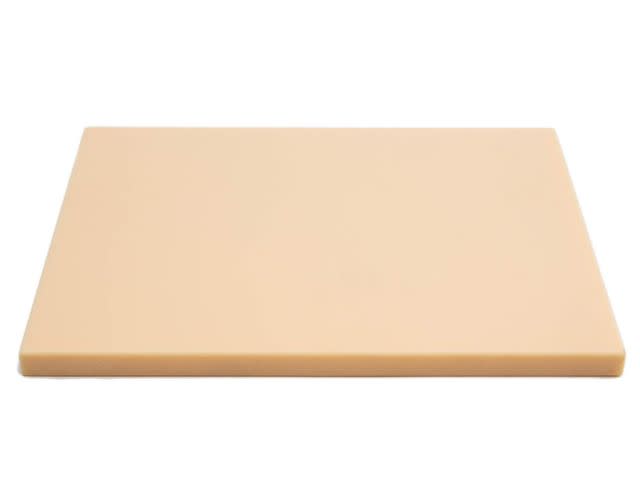
Serious Eats / Vicky Wasik
The Best Carving Board: The BoardSmith Maple End-Grain Cutting Board

What we liked; Carving boards have a trench around the edge to collect juice as meat is sliced. Some include additional handy features like raised grips in the center to keep meat from slipping as it's handled. In our review of the best carving boards, the Maple End Grain Cutting Board from The Boardsmith (with an added juice well!) excelled at every task, and it's customizable. You can add finger grooves, feet, and select a size. If you go sans feet, the board's reversible, too. And you're not imagining it: this is our favorite wooden cutting board—just with an added juice well. When something works, it works—ya know? (Note: If you’re hoping to buy a carving board on a budget, we recommend the Extra Large Walnut Carving Board from Virginia Boys.)
What we didn't like: Besides its heavy weight (and steep pricetag) there's really not much to dislike about this board.
Price at time of publish: $355.
Key Specs
Weight: 18 pounds
Customizations available: Feet; juice groove; finger grooves; sizing
Wood type: Maple
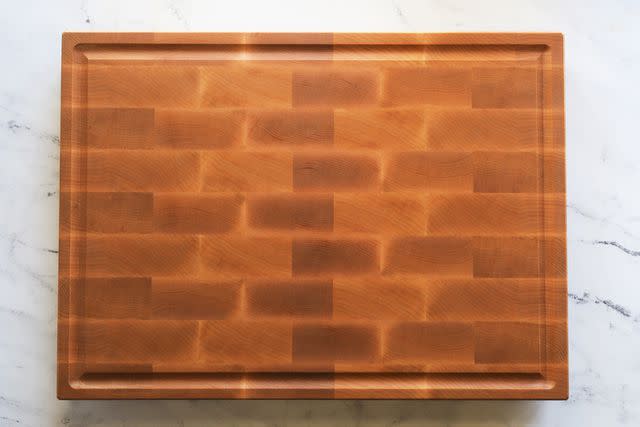
Serious Eats / Taylor Murray
FAQs
How do you clean a cutting board?
What material is your cutting board made from? Plastic cutting boards can be washed in hot, soapy water, rinsed clean, and air-dried. Most plastic boards can be cleaned in the dishwasher, too. A wooden cutting board requires a little extra care, but it’s not as fussy to wash as you may think. Simply suds up the board with a sponge or bristle brush, rinse clean, then dry excess water with a towel. Dry it upright, or sitting on a cooling rack to aid in air flow and quick drying—this will prevent cracking and warping over time.
How do you oil a cutting board?
Oiling your wooden cutting board is key for longevity; it conditions the wood, which prevents cracks and splits. It also provides a protective sealant over the surface, which impedes bacterial growth. Use food-grade mineral oil (not a perishable oil, like olive oil), and begin by pouring a generous layer over the top. Rub it in with a towel—it’s good to dedicate a specific towel for this purpose—and let the oil sink into the board for a few minutes. This may be repeated on all sides of the cutting board, and should be done whenever the board looks dry or thirsty. That could be as often as monthly, or as infrequently as a handful of times a year.
Should you buy a bamboo cutting board?
We don’t recommend buying a bamboo cutting board. Although they are often less expensive than maple or walnut boards, bamboo is hard on knives. You’ll find yourself needing to sharpen your blades more often if you chop and slice on bamboo.
Read More: We Tested 7 Plastic Cutting Boards—Here Are Our Favorites

